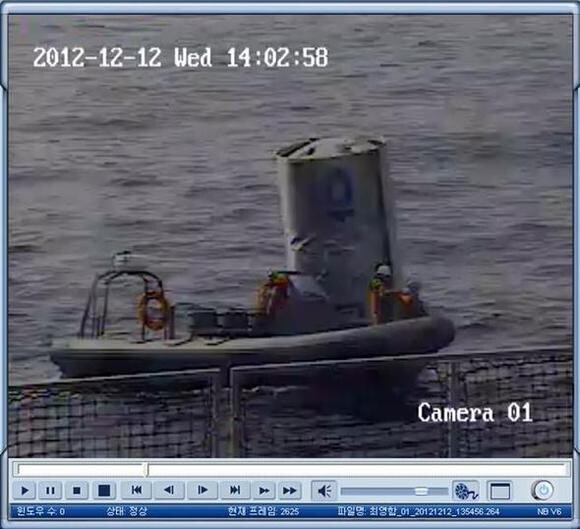hankyoreh
Links to other country sites 다른 나라 사이트 링크
North Korean rocket debris recovered in Yellow Sea

By Son Won-je, staff reporter
The South Korean navy has salvaged debris believed to be the fuel tank for the first stage of the Eunha-3, the long-range rocket launched on Dec. 12 by North Korea.
The debris was found with Korean lettering corresponding to the sounds “Eun” and “Ha,” which is believed to be from the words “Eunha-3” written on the rocket’s fuselage.
A senior Ministry of National Defense official said on Dec. 14, “Military experts from the Agency for Defense Development and civilian experts who were involved in the development of the Naro rocket will the military’s investigation team”.
American experts, with experience in analyzing Soviet and Iranian missiles, will reportedly join the effort as technical advisors.
Spokesman Kim Min-seok described the circumstances of the debris’s discovery at a Dec. 13 briefing. “One of our ‘Sejong the Great’ destroyers found debris from a North Korean rocket floating in the waters 160km west of the Byeongsan Peninsula at around 11:29 on Wednesday morning,” Kim explained. “A high-speed boat from the nearby Choe Yeong patrol ship was dispatched to attach it to a float. A few hours later it sank, and it currently sits at a depth of about 80 meters.”
Kim went on to say that a Cheonghaejin salvage and rescue ship was sent to the site, with plans to begin salvage efforts at around 4pm once the currents changed.
The debris, which measures 7.6m in length and 2.4m in diameter and weighs 3.2 tons, is believed by military authorities to be from a fuel tank for the Unha-3’s first stage. In particular, it is thought to come from the middle section of the boost0er, which bore the name of the rocket.
Kwon Yong-soo, a professor at Korea National Defense University and expert on missiles, said the fuselage from the first stage appeared to have separated during the fall and broken apart on impact.
“The bottom part of the fuselage, where the engine and ignition engine are, sank right away, while the part with the empty fuel tank appears to have been floating on the surface when it was discovered,” he explained.
The military is now hoping the debris will answer questions about the fuel used for the Eunha-3, the quality of material in its fuselage, and the thrust of its first stage. While North Korea is known to use a nitric acid oxidizer that can be stored as room temperature as its fuel, the specific ingredients have not been revealed to the outside.
The salvage effort involves deep-sea divers from the Cheonghaejin attaching a chain to the debris to hoist it up to the surface. The divers, who are part of the Ship Salvage Unit, descend to the ocean bottom on a personnel transfer capsule, wearing dry suits to maintain their body temperature under the cold deep-sea conditions. The capsule is capable of supplying oxygen to three divers for 72 hours.
There is a chance North Korea could ask for the debris back. But Kim said South Korea would not comply with such a request.
“We view the Eunha-3 as a weapon [missile] belonging to an enemy nation, and this launch was a violation of UN Resolution 1874 in terms of international law,” he explained. “We’re not giving it back.”
Please direct questions or comments to [english@hani.co.kr]

Editorial・opinion
![[Guest essay] Maybe Korea’s rapid population decline is an opportunity, not a crisis [Guest essay] Maybe Korea’s rapid population decline is an opportunity, not a crisis](https://flexible.img.hani.co.kr/flexible/normal/500/300/imgdb/original/2024/0430/9417144634983596.jpg) [Guest essay] Maybe Korea’s rapid population decline is an opportunity, not a crisis
[Guest essay] Maybe Korea’s rapid population decline is an opportunity, not a crisis![[Column] Can Yoon steer diplomacy with Russia, China back on track? [Column] Can Yoon steer diplomacy with Russia, China back on track?](https://flexible.img.hani.co.kr/flexible/normal/500/300/imgdb/original/2024/0430/1617144616798244.jpg) [Column] Can Yoon steer diplomacy with Russia, China back on track?
[Column] Can Yoon steer diplomacy with Russia, China back on track?- [Column] Season 2 of special prosecutor probe may be coming to Korea soon
- [Column] Park Geun-hye déjà vu in Yoon Suk-yeol
- [Editorial] New weight of N. Korea’s nuclear threats makes dialogue all the more urgent
- [Guest essay] The real reason Korea’s new right wants to dub Rhee a founding father
- [Column] ‘Choson’: Is it time we start referring to N. Korea in its own terms?
- [Editorial] Japan’s rewriting of history with Korea has gone too far
- [Column] The president’s questionable capacity for dialogue
- [Column] Are chaebol firms just pizza pies for families to divvy up as they please?
Most viewed articles
- 1Under conservative chief, Korea’s TRC brands teenage wartime massacre victims as traitors
- 2Months and months of overdue wages are pushing migrant workers in Korea into debt
- 3First meeting between Yoon, Lee in 2 years ends without compromise or agreement
- 4[Guest essay] Maybe Korea’s rapid population decline is an opportunity, not a crisis
- 5[Column] Can Yoon steer diplomacy with Russia, China back on track?
- 6‘We must say no’: Seoul defense chief on Korean, USFK involvement in hypothetical Taiwan crisis
- 7After election rout, Yoon’s left with 3 choices for dealing with the opposition
- 8Dermatology, plastic surgery drove record medical tourism to Korea in 2023
- 9[Column] Behind factional animus of Korean politics, victim mentality festers
- 10[Exclusive] Hanshin University deported 22 Uzbeks in manner that felt like abduction, students say